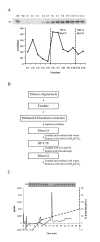STIL, a peculiar molecule from styles, specifically dephosphorylates the pollen receptor kinase LePRK2 and stimulates pollen tube growth in vitro
- PMID: 20175921
- PMCID: PMC2844069
- DOI: 10.1186/1471-2229-10-33
STIL, a peculiar molecule from styles, specifically dephosphorylates the pollen receptor kinase LePRK2 and stimulates pollen tube growth in vitro
Abstract
Background: LePRK1 and LePRK2 are two pollen receptor kinases localized to the plasma membrane, where they are present in a high molecular weight complex (LePRK complex). LePRK2 is phosphorylated in mature and germinated pollen, but is dephosphorylated when pollen membranes are incubated with tomato or tobacco style extracts.
Results: Here we show that LePRK2 dephosphorylation is mediated by a heat-, acid-, base-, DTT- and protease-resistant component from tobacco styles. Using LePRK2 phosphorylation as a tracking assay for purification, style exudates were subjected to chloroform extraction, anionic exchange, and C18 reverse-phase chromatography columns. We finally obtained a single ~3,550 Da compound (as determined by UV-MALDI-TOF MS) that we named STIL (for Style Interactor for LePRKs). STIL increased pollen tube lengths of in vitro germinated pollen in a dose-dependent manner.
Conclusion: We propose that the LePRK complex perceives STIL, resulting in LePRK2 dephosphorylation and an increase in pollen tube growth.
Figures





Similar articles
-
The receptor kinases LePRK1 and LePRK2 associate in pollen and when expressed in yeast, but dissociate in the presence of style extract.Proc Natl Acad Sci U S A. 2003 May 27;100(11):6860-5. doi: 10.1073/pnas.0631728100. Epub 2003 May 14. Proc Natl Acad Sci U S A. 2003. PMID: 12748390 Free PMC article.
-
Oligomerization studies show that the kinase domain of the tomato pollen receptor kinase LePRK2 is necessary for interaction with LePRK1.Plant Physiol Biochem. 2012 Apr;53:40-5. doi: 10.1016/j.plaphy.2012.01.008. Epub 2012 Jan 14. Plant Physiol Biochem. 2012. PMID: 22306355
-
LeSTIG1, an extracellular binding partner for the pollen receptor kinases LePRK1 and LePRK2, promotes pollen tube growth in vitro.Plant J. 2004 Aug;39(3):343-53. doi: 10.1111/j.1365-313X.2004.02139.x. Plant J. 2004. PMID: 15255864
-
[Regulation of pollen tube growth by reversible protein phosphorylation].Yi Chuan. 2014 Aug;36(8):766-78. doi: 10.3724/SP.J.1005.2014.0766. Yi Chuan. 2014. PMID: 25143274 Review. Chinese.
-
The essential role of anionic transport in plant cells: the pollen tube as a case study.J Exp Bot. 2011 Apr;62(7):2273-98. doi: 10.1093/jxb/err036. J Exp Bot. 2011. PMID: 21511914 Review.
Cited by
-
Receptor-like kinases as surface regulators for RAC/ROP-mediated pollen tube growth and interaction with the pistil.AoB Plants. 2011;2011:plr017. doi: 10.1093/aobpla/plr017. Epub 2011 Aug 19. AoB Plants. 2011. PMID: 22476487 Free PMC article.
-
Mutations in two putative phosphorylation motifs in the tomato pollen receptor kinase LePRK2 show antagonistic effects on pollen tube length.J Biol Chem. 2011 Feb 11;286(6):4882-91. doi: 10.1074/jbc.M110.147512. Epub 2010 Dec 3. J Biol Chem. 2011. PMID: 21131355 Free PMC article.
-
FERONIA receptor-like kinase regulates RHO GTPase signaling of root hair development.Proc Natl Acad Sci U S A. 2010 Oct 12;107(41):17821-6. doi: 10.1073/pnas.1005366107. Epub 2010 Sep 27. Proc Natl Acad Sci U S A. 2010. PMID: 20876100 Free PMC article.
-
Whole genome analysis of gene expression reveals coordinated activation of signaling and metabolic pathways during pollen-pistil interactions in Arabidopsis.Plant Physiol. 2011 Apr;155(4):2066-80. doi: 10.1104/pp.110.169813. Epub 2011 Feb 11. Plant Physiol. 2011. PMID: 21317340 Free PMC article.
-
Phylogenetic analysis of STK gene family and Usp domain in maize.Mol Biol Rep. 2014 Dec;41(12):8273-84. doi: 10.1007/s11033-014-3728-y. Epub 2014 Oct 19. Mol Biol Rep. 2014. PMID: 25326719
References
-
- Kim HU, Cotter R, Johnson S, Senda M, Dodds P, Kulikauska R, Tang W, Ezcura I, Herzmark P, McCormick S. New pollen-specific receptor kinases identified in tomato, maize and Arabidopsis: the tomato kinases show overlapping but distinct localization patterns on pollen tubes. Plant Mol Biol. 2002;50(1):1–16. doi: 10.1023/A:1016077014583. - DOI - PubMed

